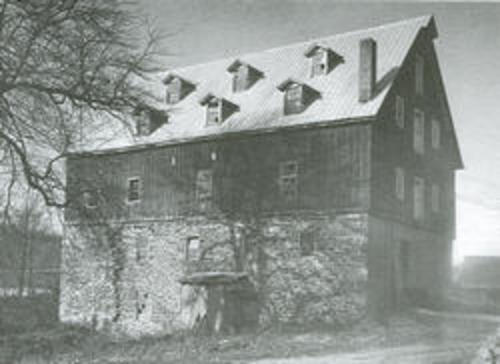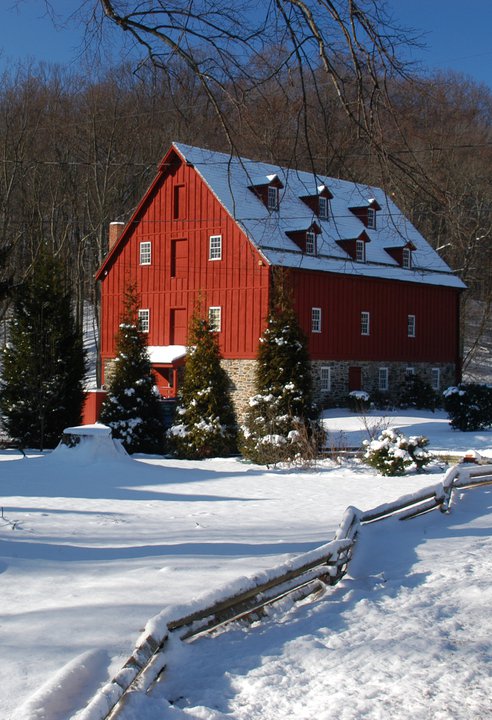Jerusalem Mill
LINTON Chronicles
Jerusalem Mill
Terry Louis Linton © 2013
Linton Research Fund Inc., Publication © 2013
LINTON & BIRD Chronicles, Volume IX, Issue 3, Fall © 2013, ISSN 1941-3521
Master millwright Isaiah Linton (1739-1775)
2023 is the 251st Anniversary of the building of Jerusalem Mill by Master millwright Isaiah Linton (1739-1775). On August 13, 1772, Isaiah Linton and David Lee entered into another agreement: "said David Lee, miller, living near Joppa, shall enter into the said premises of said Lee's Merchant Mill, and set forth into the milling, grinding, and manufacturing business." David Lee, also, agreed to pay "one-half the said profits, emolument, and advantages, arising from said mill, for a term of four years, to said Isaiah Linton, millwright."{42} On September 7, 1772, Isaiah and Sarah Linton sold to David Lee a part of Bonds Water Mills, containing a 50-acre mill seat, mill dam, and saw mill. David Lee paid only five shillings for this valuable merchant mill and seat. This sum was just enough to cover the court recording fee.{43} Isaiah's fourth mill, known as Lee's Merchant Mill and the Jerusalem Merchant Mill, remained in continuous operation for 188 years until 1960 and is standing today, some 240 years later. The Jerusalem Merchant Grist Mill is now under the care of The Friends of Jerusalem Mill and is listed on the National Register of Historic Places.
Extracted from: The Jerusalem Mill (And Its Forgotten Millwright) (article, Terry L. Linton © 1987) (Copyright The Publication of the Society for the Preservation of Old Mills, © 1987.) (ISSN 0276-3338.) Published in (Old Mill News, Vol. XV, No., 2. Whole Number 59., Spring, 1987; pp 7-8.)
_____________________________
History of Jerusalem Mill Village
Jerusalem Mill
Extracted from Jerusalem Mill Village website Historic Jerusalem Mill Village
In 1768 Zacheas Onion engaged Quaker millwright Isaiah Linton, of Bucks County, Pennsylvania, to repair and improve the existing ironworks and mills. Linton brought his family and friends into the venture, including miller David Lee.
In September 1769, millwright Isaiah Linton and miller David Lee entered into a partnership to build and operate a grist mill. They purchased the Jerusalem land tract which was advantageously located on the fall line of the Little Gunpowder River. In August of 1772, the project was completed, and David Lee began milling operations.
Linton began purchasing water and milling rights, and property. He eventually built eight water-powered mills along the Little Gunpowder River. The site of his fourth mill, which he completed in 1772, endured to become the centerpiece of Jerusalem Mill Village, a Quaker village that thrived into the very early 20th century. David Lee agreed to operate Lee's Merchant Mill and divide the profits equally with Linton. By this time there were several other buildings located around the mill. A sawmill had been in operation on site for a number of years. A succession of owners operated the gristmill until 1961, when the last miller died.
The Gunshop
The gunshop, located behind the mill, is believed to have been used by David Lee to produce muskets for the Maryland militia during the early part of the Revolutionary War. This building has also been used as a coopers shop and a dwelling. The blacksmith shop and homes for the Lee family and workers were also built during this period. The burgeoning village also contained a number of outbuildings usually associated with the support of families and a mill.
According to Lee and Linton family tradition, in the early years of the Revolutionary War, David Lee and several other Quakers made black walnut stocks and assembled muskets for the patriot cause in two-story stone building behind the gristmill. Although the building was used for a variety of purposes throughout its history, it is commonly known as the Gunshop.
David Lee's son and heir, Ralph Sackett Lee, successfully expanded the village's operations. By the early 19th century there were several major additions to the village including the Lee mansion, several tenant dwellings and a large bank barn.By mid 19th century, most of the village was in place. This era also produced one of the more colorful events in the village when, in 1864, Confederate Major Harry Gilmor raided the general store located at the east end of the village. After the Civil War, all of the village's operations were gradually leased out then eventually sold. In the 1870s the gristmill became known as Jerusalem Merchant Mill.
Extracted from Jerusalem Mill Village website http://www.jerusalemmill.org/history.html
________________________
Jerusalem Mill
Updated February 7, 2009: To find out more information on Isaiah Linton's Jerusalem Mill, view the Jerusalem Mill Site. This Hartford County, (originally in Baltimore County) Maryland stone water grist mill was designed and constructed by Quaker, Master Millwright, Isaiah Linton (1739-1775). Isaiah started construction of this mill in 1771 and finished in August 1772. Isaiah then sold the mill to his business partner, miller, cousin, David Lee (1739-1815).
Friends of Jerusalem Mill
Updated February 7, 2009: The Friends of Jerusalem Mill was organized, in 1985, by Harry Sanders, to restore the gristmill, the most prominent building in the old quaker village. In 1987, Jerusalem Mill Village earned a listing on the National Register of Historic Places. Today, the gristmill's ground floor serves as the Museum and Visitor Center, Under the direction of Curator, Chris Scovill. The upper stories serve as the headquarters of the Gunpowder Falls State Park.
View the Jerusalem Mill Photo Gallery (Coming soon)
************************
Articles
The Forgotten Millwright, Isaiah Linton (1739-1775) Terry Louis Linton © 1986
New Hope For Maryland's Jerusalem Mill Terry Louis Linton © 1987
Master millwright Isaiah LINTON (1739-1775) (Brief Historical Sketch) Terry Louis Linton © 1999
Quaker master millwright Isaiah LINTON (1739-1775) Project Terry Louis Linton © 2007
Friends of Jerusalem Mill Silver Jubilee Harry Sanders & Chris Scovill © 2010
As the Mill Wheel Turns Chris Scovill © 2010
Look for the upcoming article Lee's Merchant Mill in a upcoming Issue of the LINTON Chronicles
Look for the upcoming article Isaiah's Quakers in a upcoming Issue of the LINTON Chronicles.
Look for the upcoming article Jericho Mill in a upcoming Issue of the LINTON Chronicles.
******************************

Above photo: Jerusalem Mill (Lee's Merchant Mill) constructed (1771-1772) by Quaker, Master Millwright, Isaiah Linton (1739-1775)........................Below photo: Master millwright, Isaiah Linton's (1739-1775) Jerusalem Mill winter snow scene Hartford County, Maryland, taken by Mitch Lebovic, in 2010. — at Historic Jerusalem Mill Village.
Historic Jerusalem Mill Village
Jerusalem Mill Village From Wikipedia, the free encyclopedia
Jericho Farm Kingsville,Baltimore County Maryland
Main Menu
Linton Research Fund, Inc., HOME PAGE
LINTON Chronicles Table of Contexts
LINTON Ancestors in the Revolutionary
LINTON Ancestors in the Civil War 1861-1865
BIRD Chronicles Table of Contents
Bird Ancestors in the Revolutionary War
BIRD Ancestors in the Civil War 1861-1865
Today's Birthdays & Anniversaries
History of the Linton Research Fund Inc., LINTON & BIRD Chronicles
LINTON & BIRD Chronicles on Facebook
![]() "Thanks for Visiting, come back when you can stay longer" Terry Louis Linton © 2007
"Thanks for Visiting, come back when you can stay longer" Terry Louis Linton © 2007
Linton Research Fund Inc., Publication © 1987-2023 “Digging for our roots”
LINTON & BIRD Chronicles
Established 1984
Quarterly Publication of the Linton Research Fund Inc. ![]()
